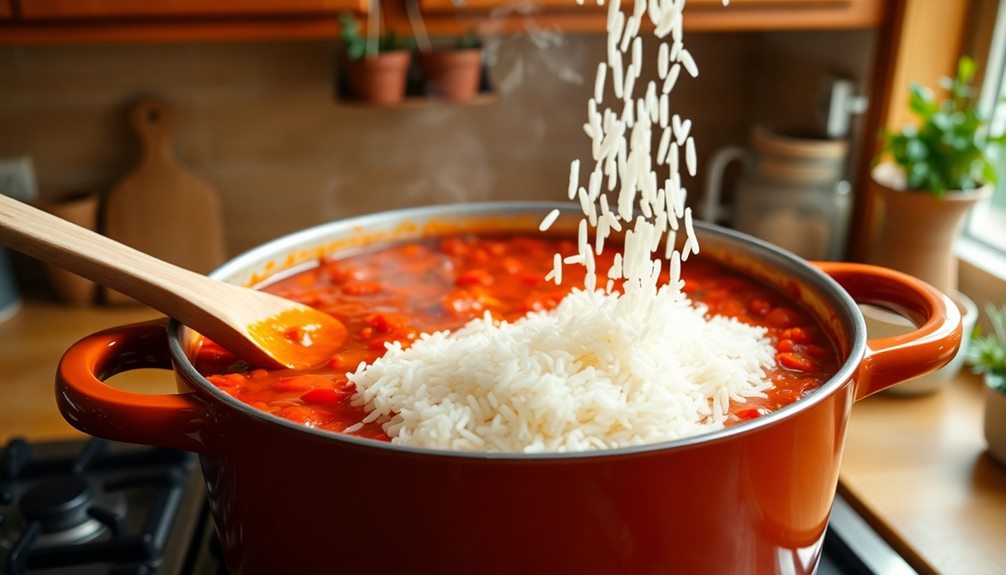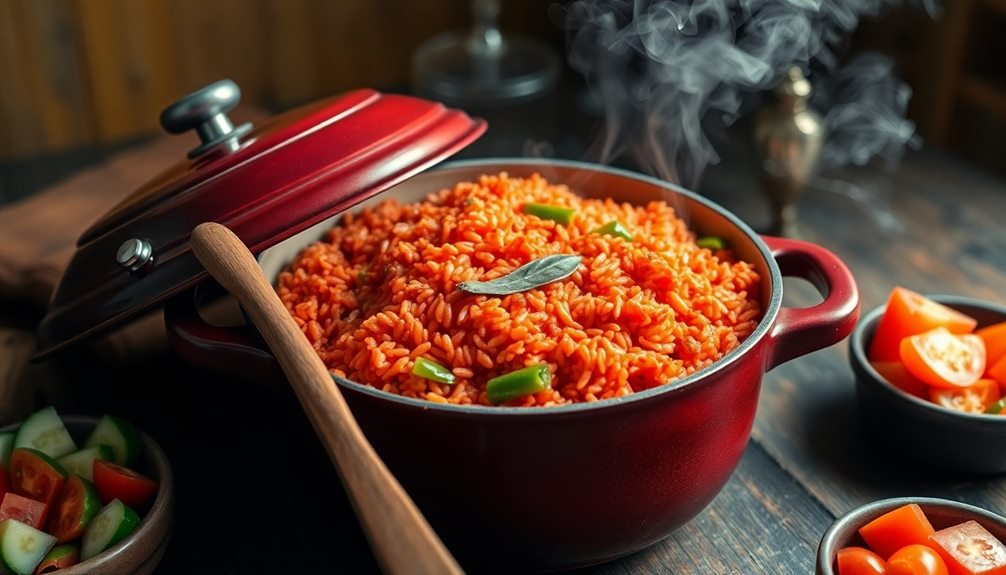Jollof rice is a mouthwatering treasure from West Africa that brings friends and families together. It's packed with vibrant flavors from tomatoes, bell peppers, and spices, making every bite a delight! You'll find it served at celebrations but enjoyed every day too. Each country adds its special twist, sparking fun debates on who makes the best version—Nigeria or Ghana? Cooking Jollof is a joyful experience, blending fresh ingredients to create a taste that warms the heart. So, gather your ingredients and get ready to learn about this iconic dish that's full of rich flavor and history!
Key Takeaways
- Jollof rice is a celebrated West African dish, known for its vibrant flavors and rich cultural significance across various communities.
- The dish's history reflects diverse culinary traditions, with unique variations emerging from different countries, especially Nigeria and Ghana.
- Key ingredients include long-grain parboiled rice, tomatoes, onions, bell peppers, and various spices, resulting in a flavorful and colorful meal.
- Jollof rice is commonly served at celebrations, fostering connections and sharing stories among families and friends in West African cultures.
- The dish is gaining global popularity, featured in food festivals and social media, highlighting authentic African cuisine and its fusion variations.
History
Jollof rice, a beloved West African dish, has a rich history that reflects the region's diverse cultures and culinary traditions. You might be surprised to learn that its roots trace back to ancient times, where different tribes and communities made their own versions. Each group added special ingredients and cooking techniques, making Jollof rice unique to their culture.
As you enjoy a plate of Jollof, think about how it connects people. It's often served at big celebrations, like weddings and birthdays, bringing families and friends together.
You'll notice that some countries, like Nigeria and Ghana, even have friendly rivalries over who makes the best Jollof rice! This competition adds to the dish's charm and excitement.
The vibrant colors you see in Jollof rice come from the tomatoes, peppers, and spices used in cooking. These ingredients tell stories of trade and cultural exchanges throughout West Africa.
Cooking Steps
To create a delicious pot of Jollof rice, start by gathering all your ingredients and equipment.
You'll need rice, tomatoes, onions, bell peppers, and spices like thyme and curry powder. Don't forget your cooking pot and a sharp knife!
First, chop your onions, tomatoes, and bell peppers. Next, blend them into a smooth paste.
In your pot, heat some oil and fry the chopped onions until they're golden brown. Then, pour in the blended mixture and let it cook for about 10-15 minutes. This is where the magic begins!
Now, add your spices and stir well. It should smell amazing!
Once that's done, add the rice and enough water to cover it. Stir everything together, then cover the pot.
Let it simmer on low heat for about 20-30 minutes.
Check the rice occasionally to make sure it's not sticking. When it's cooked and fluffy, your Jollof rice is ready to serve!
Enjoy it with your favorite proteins or veggies. This dish is sure to bring smiles to the table, so dig in and savor every bite!
Step 1. Gather All Ingredients Needed

Before diving into the cooking process, it's essential to gather all the ingredients needed for a perfect Jollof rice dish. This step is super important because having everything ready makes cooking so much easier and more fun!
First, you'll need long-grain parboiled rice, which cooks up fluffy and delicious. Next, grab some fresh tomatoes, onions, and bell peppers—these will create a rich and flavorful base. Don't forget vegetable oil, as it helps everything blend together and taste amazing. You'll also need chicken or vegetable broth to add depth to your dish.
Spices are key to a great Jollof rice! Make sure you have salt, black pepper, and a bit of thyme. If you like a little heat, consider adding some cayenne pepper or chili powder.
And remember, you can also include your favorite proteins, like chicken, shrimp, or beans, to make it heartier.
Lastly, gather any additional vegetables you enjoy, like carrots or peas.
With everything collected, you're ready to create a mouthwatering Jollof rice that's sure to impress your family and friends! So, roll up your sleeves, and let's get cooking!
Step 2. Blend Tomatoes and Peppers

Creating a flavorful base starts with blending the tomatoes and peppers. You'll want to grab ripe tomatoes and some vibrant red or green bell peppers. These colorful veggies will give your Jollof rice that delicious taste everyone loves!
First, wash the tomatoes and peppers under cool water to make sure they're nice and clean. Next, chop them into smaller pieces so they blend easily. If you're feeling adventurous, you can add a bit of onion and a touch of garlic for extra flavor!
Now, place the chopped veggies into a blender. Don't forget to add a splash of water to help them blend smoothly. Secure the lid tightly, then blend everything until it's nice and smooth. You want a rich, thick mixture that's bursting with color and flavor.
Once you've finished, take a moment to admire your work! This blended mixture is the heart of your Jollof rice. It's going to create a magical taste that'll make everyone at the table smile.
Step 3. Simmer With Spices and Herbs

Once you've got your blended tomatoes and peppers ready, it's time to infuse them with spices and herbs to elevate the flavor of your Jollof rice.
Start by heating some oil in a large pot over medium heat. Once it's hot, carefully pour in your blended mixture. You'll want it to bubble and sizzle a bit—that's the sound of flavor coming to life!
In Italian cuisine, the skillful use of spices is also essential, as seen in dishes like Cacciucco, where a blend of seafood and spices creates a rich, savory experience.
Now, it's time to add your spices. Sprinkle in some salt, black pepper, and a pinch of thyme. For that extra kick, you might want to toss in a teaspoon of curry powder or paprika. These spices will make your dish smell amazing!
Stir everything together and let it simmer for about 10-15 minutes. This simmering time is crucial; it allows the spices to meld with the tomato and pepper mix, creating a rich, aromatic base.
While it simmers, don't forget to taste it! If you think it needs more spice, add a little extra.
Once it thickens and darkens, you know you're on the right track. Your Jollof rice is about to become something truly special!
Step 4. Add Rice to Mixture

With your aromatic tomato and pepper mixture bubbling away, it's time to introduce the star of the show—rice. Grab your rinsed rice and gently fold it into the pot, letting it mingle with all those delicious flavors.
Make sure every grain gets coated in the rich sauce. You'll want to use long-grain rice, like basmati or jasmine, for that perfect fluffy texture.
As you add the rice, take a moment to enjoy the colorful sight. It's like a party in your pot! Stir everything together, ensuring the rice is evenly distributed. You'll notice the vibrant colors of the tomatoes and peppers blending beautifully with the grains.
Now, it's essential to add water or broth to your mixture. This will help the rice cook properly and absorb all those delightful flavors. Pour in just enough to cover the rice, but be careful not to drown it! A little salt can also enhance the taste, so sprinkle some in if you'd like.
Once everything's combined, give it a gentle stir, then cover your pot. Get ready for the delightful aroma that'll fill your kitchen as the rice cooks to perfection!
Step 5. Cook Until Rice Absorbs Liquid

As the pot simmers, you'll want to keep an eye on the rice. This is where the magic happens!
You've already added the rice to the delicious mixture, and now it's time to let it soak up all those wonderful flavors. Turn the heat down to medium-low, so it doesn't boil over. Cover the pot with a lid, and let it cook gently.
In about 20 to 30 minutes, check on it. You'll see the rice absorbing the liquid, transforming into fluffy, flavorful grains. If you notice that the rice is still a bit hard and there's no liquid left, you can add a splash of water. Just a little will do!
Keep the lid on tightly while it finishes cooking. The steam helps the rice cook evenly, so it's super important to keep it covered.
Once the rice is tender and has absorbed all the liquid, it's almost time to enjoy your Jollof! Don't forget to fluff it with a fork before serving. This step makes it extra delightful! You're just a few moments away from tasting this amazing dish!
Final Thoughts
When you take a moment to reflect on Jollof rice, it's clear that this dish is more than just a meal; it's a cultural icon that brings people together. When you take a moment to reflect on Jollof rice, it's clear that this dish is more than just a meal; it's a cultural icon that brings people together. Its rich flavors and vibrant colors are a testament to the culinary traditions of West Africa, sparking lively debates over whose version reigns supreme. Much like how Jollof rice connects people, exploring diverse foods from global cultures, such as learning about Brazilian açaí bowl benefits, can also open us up to nutritious and flavorful ways of coming together through shared experiences.
Imagine gathering with family and friends, sharing laughter and stories as you enjoy a steaming pot of Jollof. That's the magic of this dish!
Jollof rice represents a rich blend of flavors and traditions, making it a favorite at celebrations and everyday meals alike.
Each country has its unique twist on the recipe, which sparks friendly debates about who makes the best Jollof. Whether it's spicy or mild, with chicken or fish, there's a version that'll tickle your taste buds.
Cooking Jollof isn't just about following a recipe; it's about creating memories.
You can hear the sizzling sounds, smell the delicious spices, and feel the warmth of togetherness.
So, the next time you sit down to enjoy Jollof rice, remember you're tasting a piece of West African culture and history.
In a world that sometimes feels divided, Jollof rice is a reminder that food has the power to unite us, one delicious bite at a time.
Enjoy every moment!
Frequently Asked Questions
What Are the Best Types of Rice for Jollof?
When making jollof, you'll want to choose long-grain rice like basmati or jasmine. They absorb flavors well and cook evenly, giving you that perfect texture for a delicious, vibrant dish everyone will enjoy.
Can Jollof Be Made Vegetarian or Vegan?
Absolutely, you can make jollof vegetarian or vegan! Just swap out meat or seafood for plant-based proteins like beans or lentils, and use vegetable broth for cooking. You'll still enjoy delicious flavors without animal products.
How Do You Store Leftover Jollof Rice?
To store leftover jollof rice, let it cool completely, then transfer it to an airtight container. You can refrigerate it for up to five days or freeze it for longer preservation. Reheat before serving.
What Are Popular Side Dishes Served With Jollof?
When enjoying jollof, consider serving it with fried plantains, coleslaw, grilled chicken, or fish. These sides complement the dish's flavors perfectly and create a delightful meal that you and your guests will love.
Are There Regional Variations of Jollof in West Africa?
Yes, there are regional variations of jollof in West Africa. Each country adds its unique twist, from Ghana's spicy version to Nigeria's richer sauce. You'll discover different flavors and cooking techniques that make each special.









